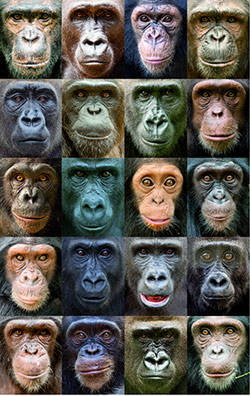
Researchers discovered that the evolutionary history of ancestral great ape populations was considerably more intricate than that of humans. Credit: University of Washington/Institut de Biologia Evolutiva
In a new DNA study, an international team of scientists reveal clues to human and ape evolution, finding that the evolutionary history of ancestral great ape populations was far more complex than that of humans.
A massive effort to catalog the genetic variation in humans, chimpanzees, gorillas, and orangutans has helped researchers piece together a model of great ape history spanning 15 million years.
The new database of great ape genetic diversity, the most comprehensive yet, elucidates the evolution and population histories of great apes from Africa and Indonesia. The resource likely will aid conservation efforts that strive to preserve their natural genetic diversity, the researchers report online in the journal Nature.
More than 75 scientists and wildlife conservationists from around the world were involved in the genetic analysis of 79 wild and captive-born great apes. They represent all six great ape species: chimpanzee, bonobo, Sumatran orangutan, Bornean orangutan, eastern gorilla western lowland gorilla, and seven subspecies. The genomes of nine humans, also part of the great ape family, also were included in the sampling.
“This is fascinating research,” said co-author Richard K. Wilson, PhD, director of The Genome Institute at Washington University School of Medicine in St. Louis, where much of the genome sequencing was performed. “Besides telling us many interesting things about the genetic relationships and diversity among our close relatives, the study provides some important lessons regarding how our own genome responds to the pressure of population changes.”
The research was led by Tomas Marques Bonet, PhD, of the Institut de Biologia Evolutiva (Consejo Superior de Investigaciones Cientificas-Universitat Pompeu Fabra) in Spain, and Evan Eichler, PhD, of the University of Washington.
Genetic variation among great apes had been largely uncharted, due to the difficulty in obtaining genetic specimens from wild apes. Conservationists in many countries, some of them in dangerous or isolated locations, helped in this recent effort, and the research team credits them for the success of the project.
“Gathering this data is critical to understanding differences between great ape species and separating aspects of the genetic code that distinguish humans from other primates,” said co-first author Peter Sudmant, a graduate student at the University of Washington.
The analysis of great ape genetic diversity is likely to reveal ways that natural selection, population growth and collapse, geographic isolation and migration, climate and geological changes, and other factors shaped primate evolution.
Learning more about great ape genetic diversity also contributes to knowledge about disease susceptibility among various primate species. Such questions are important to conservation efforts and human health. The Ebola virus is responsible for thousands of gorilla and chimpanzee deaths in Africa, and the origin of HIV, the virus which causes AIDs, is the simian immunodeficiency virus (SIV).
The scientists also are looking for the genetic differences between humans and other great apes that might confer traits that are uniquely human. Those species’ differences may direct researchers to portions of the human genome associated with cognition, speech or behavior, providing clues to which mutations might underlie neurological diseases.
The new resource of ape genetic diversity also will help address the challenging plight of great ape species on the brink of extinction. The resource provides an important tool to enable biologists to identify the origin of great apes poached for their body parts or hunted down for bush meat. The research also explains why current zoo breeding programs, which have attempted to increase the genetic diversity of captive great ape populations, have resulted in captive ape populations that are genetically dissimilar to their wild counterparts.
The findings also delineate the many changes that occurred along each of the ape lineages as they became separated from each other through migration, geological change, and climate events. The formation of rivers, the partition of islands from the mainland and other natural disturbances all have served to isolate groups of apes. Isolated populations then may be exposed to a unique set of environmental pressures, resulting in population fluctuations and adaptations depending on the circumstances.
Even though early human-like species were present at the same time as the ancestors of some present-day great apes, the researchers found that the evolutionary history of ancestral great ape populations was far more complex than that of humans.
Compared to our closest relatives, chimpanzees, human history appears “almost boring,” the researchers conclude. The last few million years of chimpanzee evolutionary history are fraught with population explosions followed by implosions demonstrating remarkable plasticity. The reasons for these fluctuations in chimpanzee population size long before our own population explosion are still unknown, however.
The research is funded by: ERC Starting Grant (260372); NIH grants HG002385, R01_HG005226, GM100233, and NSF HOMINID grant 1032255; MICINN (Spain) BFU2011-28549, BFU2010-19443, BFU2009-13409-C02-02, Direcció General de Recerca, Generalitat de Catalunya (Grup de Recerca Consolidat 2009 SGR 1101); ERC Advanced Grant (233297) and Max Planck Society to Svante Paabo; Danish Council for Independent Research | Natural Sciences to HS; Spanish Grant (CGL-2010-20170) and Zoo de Barcelona (Beca PRIC) ; EUPRIM-Net to BPRC; DP1ES022577-04 NIH grant; and NSF Grant 0755823.
Reference: “Great ape genetic diversity and population history” by Javier Prado-Martinez, Peter H. Sudmant, Jeffrey M. Kidd, Heng Li, Joanna L. Kelley, Belen Lorente-Galdos, Krishna R. Veeramah, August E. Woerner, Timothy D. O’Connor, Gabriel Santpere, Alexander Cagan, Christoph Theunert, Ferran Casals, Hafid Laayouni, Kasper Munch, Asger Hobolth, Anders E. Halager, Maika Malig, Jessica Hernandez-Rodriguez, Irene Hernando-Herraez, Kay Prüfer, Marc Pybus, Laurel Johnstone, Michael Lachmann, Can Alkan, Dorina Twigg, Natalia Petit, Carl Baker, Fereydoun Hormozdiari, Marcos Fernandez-Callejo, Marc Dabad, Michael L. Wilson, Laurie Stevison, Cristina Camprubí, Tiago Carvalho, Aurora Ruiz-Herrera, Laura Vives, Marta Mele, Teresa Abello, Ivanela Kondova, Ronald E. Bontrop, Anne Pusey, Felix Lankester, John A. Kiyang, Richard A. Bergl, Elizabeth Lonsdorf, Simon Myers, Mario Ventura, Pascal Gagneux, David Comas, Hans Siegismund, Julie Blanc, Lidia Agueda-Calpena, Marta Gut, Lucinda Fulton, Sarah A. Tishkoff, James C. Mullikin, Richard K. Wilson, Ivo G. Gut, Mary Katherine Gonder, Oliver A. Ryder, Beatrice H. Hahn, Arcadi Navarro, Joshua M. Akey, Jaume Bertranpetit, David Reich, Thomas Mailund, Mikkel H. Schierup, Christina Hvilsom, Aida M. Andrés, Jeffrey D. Wall, Carlos D. Bustamante, Michael F. Hammer, Evan E. Eichler and Tomas Marques-Bonet, 3 July 2013, Nature.
DOI: 10.1038/nature12228


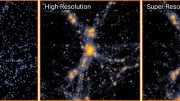
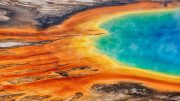
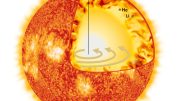

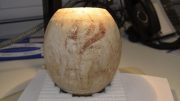
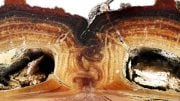

I’m sorry. We are not actually talking about evolution here. Natural selection and mutational activity does not provide the staggeringly complex new customized structural and enzymatic protein masses required for the fabulous levels of sophistication in brain function that humans have and apes never did and never will. The complexity must be imposed on the genome. It can never arise from it. Speciation, natural selection and population dynamics cause devolution, not evolution, because they lower the quantity of available genetic diversity. When we select, we isolate information out. Evolution requires the opposite.